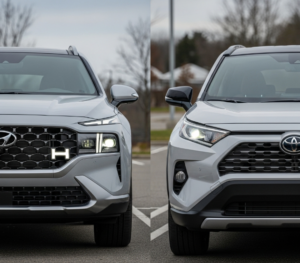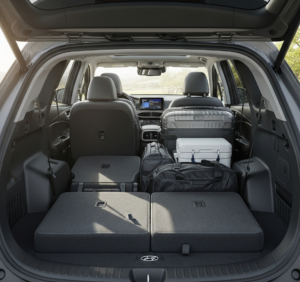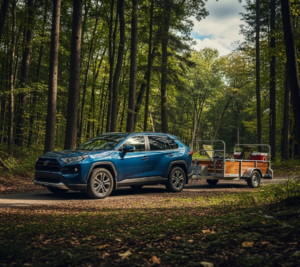Hyundai SantaFe vs. Toyota RAV4. Choosing a new SUV is a major decision—it’s not just a car, but an investment in a vehicle that will carry your family and memories for years to come. In the world of practical, reliable, and family-friendly SUVs, the debate between the Hyundai SantaFe and the Toyota RAV4 is a classic one. Both are exceptional vehicles, but they cater to slightly different needs and preferences.
You’re here because you need a clear, no-nonsense breakdown of the facts. You’re tired of sifting through endless specifications and just want to know which one is the better fit for your life. That’s exactly what this guide is for. We’ll compare these two popular SUVs side-by-side, from power and size to features and long-term value, so you can drive away with confidence.
Performance & Power: A Tale of Two Engines
When you hit the gas pedal, you’ll feel an immediate difference between these two SUVs. The 2024 Hyundai Santa Fe, in its standard gas-powered form, is a powerhouse. It comes with a turbocharged 2.5-liter four-cylinder engine that delivers a robust 277 horsepower and 311 lb-ft of torque. This translates to a punchy, responsive feel on the road, making highway merging and passing a breeze.
The 2024 Toyota RAV4, on the other hand, takes a more balanced approach. Its standard 2.5-liter four-cylinder engine produces 203 horsepower and 184 lb-ft of torque. While this is more than enough for daily driving, it’s a noticeable step down from the Santa Fe’s sheer power. The RAV4 is a workhorse—reliable and efficient—but it doesn’t offer the same level of acceleration as its Hyundai counterpart. This is a key consideration if you prioritize a more exhilarating driving experience.
Hyundai SantaFe vs RAV4 Fuel Economy
Fuel efficiency is often a top priority for SUV buyers, and this is where the Hyundai Santa Fe vs RAV4 fuel economy comparison gets interesting. The Toyota RAV4 has a clear advantage in its base model. The standard front-wheel-drive (FWD) RAV4 boasts an EPA-estimated 27 city / 35 highway MPG.
The Santa Fe’s more powerful engine comes with a trade-off in fuel economy. The standard FWD model gets an EPA-estimated 20 city / 29 highway MPG. If saving at the pump is your number one concern, the RAV4’s gasoline model is the winner.
However, both vehicles offer compelling hybrid options. The Toyota RAV4 Hybrid gets a remarkable 41 city / 38 highway MPG, while the Hyundai Santa Fe Hybrid isn’t far behind with an impressive 35 city / 34 highway MPG. For drivers prioritizing efficiency above all else, either hybrid is an excellent choice.
Interior & Size: Space for the Whole Family
The most significant difference between these two vehicles is their size. The RAV4 is a compact SUV, while the redesigned 2024 Santa Fe has grown into a mid-size SUV, and the numbers reflect that. The Santa Fe offers an available third row, giving it a maximum seating capacity of up to seven passengers. The RAV4 is strictly a two-row SUV that seats five.
This size difference also extends to cargo space. With all seats in place, the Santa Fe offers more cargo volume. When the rear seats are folded down, the Santa Fe’s larger dimensions give it a clear advantage, making it a better choice for large shopping trips or hauling bulky items.
Comparison Table: Key Metrics at a Glance
Towing & Capability
For those who need to haul a small trailer, boat, or camper, towing capacity is a major factor. The Hyundai Santa Fe towing capacity stands out here. When properly equipped with the optional towing package, the Santa Fe can tow up to a maximum of 4,500 pounds.
The Toyota RAV4’s towing capacity, while respectable for its class, is less at 3,500 pounds with the Adventure and TRD Off-Road trims. This is a significant difference that could make or break your decision if you plan on towing more than a small trailer.
Features, Tech, & Warranty: The Long-Term Value
Both vehicles are packed with modern technology, including large infotainment screens, digital instrument clusters, and comprehensive safety suites. However, the Santa Fe often offers a more premium feel with its advanced features like dual wireless charging pads and an available UV-C sanitizing compartment.
Perhaps the most compelling argument for the Santa Fe is its warranty. Hyundai offers “America’s Best Warranty,” which includes a 10-year/100,000-mile powertrain warranty and a 5-year/60,000-mile new vehicle limited warranty. Toyota’s warranty, while solid, is less extensive, with a 5-year/60,000-mile powertrain warranty and a 3-year/36,000-mile new vehicle limited warranty. This superior coverage provides a significant peace of mind that can save you money in the long run.
Final Verdict: Who Should Buy Which SUV?
Choosing between the Santa Fe and the RAV4 is about prioritizing what matters most to you.
- The Hyundai Santa Fe is best for: Families who need more space, seating for up to seven passengers, and a more powerful engine. It’s also the better choice for those who plan on towing heavier loads and value a more comprehensive warranty for long-term peace of mind. The Santa Fe feels more luxurious and offers a premium suite of technology.
- The Toyota RAV4 is the better choice for: The driver who values fuel efficiency above all else. Its gas model offers better MPG than the Santa Fe, and its hybrid variant is one of the most efficient on the market. It’s a great option for smaller families or individuals who need a reliable, practical, and highly efficient daily driver and aren’t concerned with a third row or maximum towing capacity.
Ultimately, both are top contenders for the title of best mid-size SUV 2024, but the right choice depends on your specific needs. Take them both for a test drive, and you’ll know which one speaks to you.
Frequently Asked Questions: Hyundai SantaFe vs. Toyota RAV4
Q1: Which SUV has better safety features?
Both the Santa Fe and the RAV4 come standard with extensive driver-assist and safety suites (Hyundai SmartSense and Toyota Safety Sense, respectively). Both include features like automatic emergency braking, lane-keeping assist, and adaptive cruise control. Higher trims of the Santa Fe, however, offer a few exclusive advanced features like a blind-spot view monitor and remote smart parking assist.
Q2: Is the Toyota RAV4 Hybrid a better value than the SantaFe Hybrid?
The Toyota RAV4 Hybrid has a higher starting price than the gas-powered RAV4 but offers significantly better fuel economy. The Hyundai Santa Fe Hybrid also provides a strong MPG boost. While the RAV4 Hybrid may have a slightly better MPG rating, the Santa Fe Hybrid offers more power and space. The “better” value depends on whether you prioritize fuel savings (RAV4) or power and size (Santa Fe).
Q3: Which vehicle holds its resale value better?
Historically, Toyota has an excellent reputation for holding its value, and the RAV4 is a prime example of this. Its widespread popularity and reputation for reliability make it a highly sought-after vehicle on the used market. While Hyundai’s resale value has improved significantly over the years, the Toyota RAV4 still has a slight edge in this department.
Hi, I’m [jeybee]. As a long-time resident of Seoul, I’m passionate about uncovering the authentic, everyday magic of Korea. This blog is my way of sharing my favorite spots, tips, and cultural insights with you, beyond the usual tourist traps.




